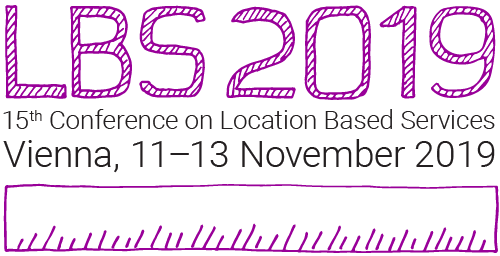Use your browser’s search function to find a specific paper.
Section I: Mobile Cartography and Augmented Reality
Juliane Cron, Bernhard Jenny, Roar Engell and Zac Lucarelli Head-mounted Augmented Reality Visualisation for Outdoor Pedestrian Navigation
Laura Schalbetter, Tiffany C.K. Kwok, Peter Kiefer and Martin Raubal Gaze-Based Interaction with Maps and Panoramas
Silvia Klettner Small Symbols With Big Effect? – A Cognitive-Affective Perspective on Map Symbolization on Small-Sized Displays
Chenyu Zuo, Linfang Ding, Edyta Paulina Bogucka and Liqiu Meng Map-based Dashboards versus Storytelling Maps
Georg Molzer and Florian Ledermann Interactive Web-based 3D Solar Shadow Map
Itziar Urbieta, Irati Mendikute, Harbil Arregui and Oihana Otaegui Concerns on Design and Performance of a Local and Global Dynamic Map
Lukáš Herman, Tomáš Řezník, Tomáš Pavelka and Šimon Leitgeb Cartographic Visualisation of Data Measured by Field Harvesters
Section II: Navigation and Wayfinding
Marina Georgati and Carsten Kessler A 3D Routing Service for Indoor Environments
Laure De Cock, Kristien Ooms, Nico Van de Weghe and Philippe De Maeyer Adapting the Type of Indoor Route Instruction to the Decision Point
Nina Vanhaeren, Kristien Ooms and Philippe De Maeyer Developing Cognitively Simple Wayfinding Systems: A Mixed Method Approach
Wangshu Wang, Silvia Klettner, Georg Gartner, Tabea Fian, Georg Hauger, Alessandra Angelini, Martin Söllner, Arnd Florack, Michael Skok and Mathias Past Towards a User-Oriented Indoor Navigation System in Railway Stations
Champika Ranasinghe and Christian Kray Adapting Navigation Support to Location Information Quality: A Human Centered Approach
Eva Nuhn and Sabine Timpf Prediction of Landmarks Using (Personalised) Decision Trees
Marcio Schmidt, Luciene Delazari, Amanda Antunes, Caroline Marchis and Rhaissa Sarot Landmark Classification for Navigation In Indoor Environments
Marcio Schmidt, Luciene Delazari, Elias Naim and Vinícius Martins Off-Route Virtual Landmarks to Help Pedestrian Indoor Navigation
Section III: Mobility and Activity Analytics
Kamil Smolak, Katarzyna Siła-Nowicka and Witold Rohm Towards Anonymous Mobility Data Through the Modelling of Spatiotemporal Circadian Rhythms
Gyözö Gidófalvi Trajectory and Mobility Based Services: A Research Agenda
Anita Graser, Johanna Schmidt, Melitta Dragaschnig and Peter Widhalm Data-driven Trajectory Prediction and Spatial Variability of Prediction Performance in Maritime Location Based Services
Cheng Fu and Robert Weibel Cross-scale Spatial Enrichment of Trajectories for Speeding Up Similarity Computing
Christian Sailer, Henry Martin, Luca Gaia and Martin Raubal Analyzing performance in Orienteering from movement trajectories and contextual information
Jiwon Lee, Jiyoung Kim and Kiyun Yu Demand Forecasting of a Public Bike-Sharing System Reflecting Dynamic Spatial Data
Ben Levy, Jack Haddad and Sagi Dalyot Automatic incident detection along freeways using spatiotemporal Bluetooth data
Minhyuck Lee, Inwoo Jeon and Chulmin Jun Time-distance Accessibility of Public Transport considering In-vehicle Crowding based on Smart card data
Inwoo Jeon, Minhyuck Lee and Chulmin Jun A Simulation Method for Adjustment of Public Transportation Routes using Geotagged Smart Card Data
Anto Aasa, Erki Saluveer, Pilleriine Kamenjuk, Janika Raun and Jan Šimbera Spatial interpolation of mobile positioning data for population statistics
Jan Šimbera and Anto Aasa Areal interpolation of spatial interaction data
Section IV: Indoor Modelling and Localization
Seula Park and Kiyun Yu Automatic Floor Matching for 3D Indoor Spatial Modeling
Sun Kwon, Hyun-Jung Kim and Ki-yun Yu Topology and Semantic based Automatic Indoor Space Subdivision from 2D Floor Plan
Guenther Retscher, Aizhan Bekenova, Arbër Fazliu, Michael Hallett, Luke Harvey and Jenny Janssen Dynamic Wi-Fi Reference Point Recognition along Public Transport Routes
Pasindu Ranasinghe, Thilanta Dammalage and Guenther Retscher A Low-cost Public Transport Tracking and Information System for Commuters in Sri Lanka
Section V: Crowdsourcing and VGI
Carsten Keßler and Grant McKenzie Consistency Across Geosocial Media Platforms
Matan Mor, Dafna Fisher Gewirtzman and Sagi Dalyot Using Geotagged Photos to Study Visitors Mobility in Urban Parks during Shadow
Andreas Petutschnig, Bernd Resch, Jen Nelles and Laxmi Ramasubramanian L’d Up: Examining the Effects of a New York City Metro Shutdown on Public Discourse Using Twitter Data
Kenzo Milleville, Dilawar Ali, Francisco Porras-Bernardez, Steven Verstockt, Nico Van de Weghe and Georg Gartner WordCrowd – A Location-Based Application to Explore the City based on Geo-Social Media and Semantics
Pierfrancesco Bellini, Paolo Nesi, Michela Paolucci, Mirco Soderi and Paola Zamperlin Snap4city Platform: Semantic to Improve Location Based Services
Tatiane Ferreira Olivatto, Fábio Noel Stanganini and Edson Augusto Melanda Drone Imagery for OpenStreetMap Sidewalk Data Enrichment
Section VI: User Issues, Motivation and Applications
Per Ole Uphaus, Oliver Neuper, Björn Beringer, Lukas Hoffmann, Simon Langenmair, Annika Ehlers and Harald Rau Barriers seen by potential local Providers of Applications using Location-Based Services
Meenu Mohan and Ana Basiri Usability analysis of 3D Maps for Pedestrian Navigation among different demographic profiles
Chenyu Zuo, Bing Liu, Linfang Ding, Edyta Paulina Bogucka and Liqiu Meng Usability Test of Map-based Interactive Dashboards Using Eye Movement Data
Mikko Rönneberg, Søren Qvist Eliasen, Pyry Kettunen, Christian Koski and Juha Oksanen Designing Access Control of a Spatial Decision Support System for Collaborative Maritime Spatial Planning
Jaeyoung Lee, Minhyuck Lee and Chulmin Jun Evacuation Simulation Considering Fire Spread and Occupants Distribution
Saeed Mehri and Ali Asghar Alesheikh A location-based service for planning tool
Aleyda Rocha Sepulveda, Eveline Wandl-Vogt and Georg Gartner Claiming Space Through Language: Conceptualizing a Location Based Cultural Space Experience
